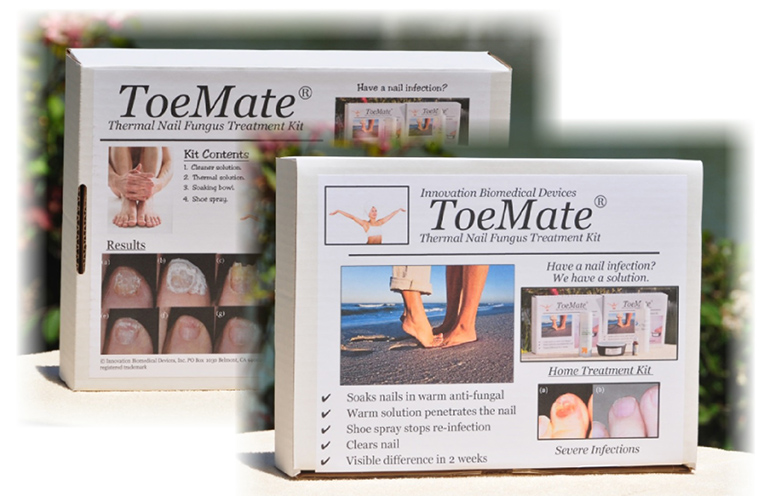

Penetration
For the medication to penetrate and reach the infection through nail keratin (which absorbs water and repels water insoluble drugs) the treatment must be at least partially water soluble. The most effective way is to immerse the infected nails in an antimicrobial that is dissolved in water to give nails absorption time. Of the 125 or so treatments for nail fungus, only three are at least partially water soluble (Kerydin, Loceryl and ToeMate Nail Soak).
Scientifically, nail keratin is hydrophilic and Kobayashi et al 1999 found that the permeation through nail keratin of a water soluble drug was much greater than a non-water soluble drug of similar molecular weight by a ratio of 90 to 1.
Energy
When nails soften in a warm shower, they’re absorbing water. Water uses heat energy to penetrate the nail but most medications are applied at room temperature. This means that most medications lack the energy to penetrate the nail. Of the 125 or so treatments for nail fungus, only one uses additional energy to help penetrate (ToeMate Nail Soak).
Scientifically, Gupchup-Malhotra et al 2000 determined the energy necessary to drive the permeation of water through a normal nail is 7.2 kcal/mole. All but one of the currently available therapies (ToeMate Nail Soak – 7.7 kcal/mol) are applied at room temperature (about 0.5 kcal/mol).
Nail thickness

Infected nails become thicker as the infection spreads making it more difficult for the medication to penetrate. To thin the nail, a cleaner can be applied to remove the excess nail and facilitate the delivery of the medication. ToeMate Kits include a cleaner that breaks up the infection creates micro-channels to help the thermal solution penetrate deeper into the nail.
Scientifically, as keratin debris accumulates, the nail becomes thicker and increases the barrier to treatment. Kobayashi 2004 found that nail penetration decreases linearly with increasing nail thickness. Quintanar 1998 found that the application of a topical keratolytic reduces nail thickness and the energy required for penetration. Keratolytics such as salicylic acid, papain, and urea are available OTC under brand names Zanaquick and Gold Cosmetics. Salicylic acid 30% is included in ToeMate Kits.
Electrostatic repulsion
Just like two magnets that repel each other, the nail plate repels medication that prevents it from penetrating (since most antifungal medications were developed to penetrate skin, not nail). To reduce repulsion and increase penetration, ToeMate kits include a neutralizer that reduces the repulsion and allows the medication to penetrate the nail.
Scientifically, also known as the Donnan effect, Kobayashi 2004 found that electrostatic repulsion further inhibits nail permeability between the keratin membrane and the diffusing molecule. QAC, a cationic antimicrobial surfactant used in ToeMate Kits reduces or eliminates the repulsion and allows the diffusing molecules to enter more readily (Unhoch 1997).
Antifungal strength
Modes of action are the mechanisms antifungal medications use to eliminate infections (e.g., attack cell membrane, disrupt DNA or protein synthesis). Of the 125 antifungal medications, only two have more than one mode of action (cyclopirox and ToeMate Nail Soak) and only the latter disrupts spore development (without it infections reoccur).
Scientifically, research from Baran et al 2005 suggests that combination therapies that use two or more antimycotics with complimentary modes of action lowers overall MIC values (disabling many cellular functions simultaneously) compared to values for the antimycotics applied individually. Infections with combinations of dermatophytes, yeasts, and molds are thought to be common but difficult to diagnose (Elewski et al 2015). Ciclopirox and ToeMate Nail Soak demonstrate more than one mode of action and ToeMate exhibits activity against spore outgrowth that prevents reinfection.
Safety
Salicylic acid, PHMB and QAC, the active ingredients in ToeMate Kits, and have been safely used in dermatology, cosmetics and public water treatments for the last sixty years.
Reduced Treatment Times & Expense
Combining ToeMate’s benefits into one treatment shortens the protocol down from 18 to 3 months or less (depending on the severity) with a simultaneous cost reduction per ounce from $4,700 for Kerydin to about $0.50 per ounce for ToeMate.
more recommended stories
 Safer Allogeneic Stem Cell Transplants with Treg Therapy
Safer Allogeneic Stem Cell Transplants with Treg TherapyA new preclinical study from the.
 Autoimmune Disorders: ADA2 as a Therapeutic Target
Autoimmune Disorders: ADA2 as a Therapeutic TargetAdenosine deaminase 2 (ADA2) has emerged.
 Kaempferol: A Breakthrough in Allergy Management
Kaempferol: A Breakthrough in Allergy ManagementKaempferol, a dietary flavonoid found in.
 Early Milk Cereal Drinks May Spur Infant Weight Gain
Early Milk Cereal Drinks May Spur Infant Weight GainNew research published in Acta Paediatrica.
 TaVNS: A Breakthrough for Chronic Insomnia Treatment
TaVNS: A Breakthrough for Chronic Insomnia TreatmentA recent study conducted by the.
 First-of-Its-Kind Gene-Edited Pig Kidney: Towana’s New Life
First-of-Its-Kind Gene-Edited Pig Kidney: Towana’s New LifeSurgeons at NYU Langone Health have.
 Just-in-Time Training Improves Success & Patient Safety
Just-in-Time Training Improves Success & Patient SafetyA study published in The BMJ.
 ChatGPT Excels in Medical Summaries, Lacks Field-Specific Relevance
ChatGPT Excels in Medical Summaries, Lacks Field-Specific RelevanceIn a recent study published in.
 Study finds automated decision minimizes high-risk medicine combinations in ICU patients
Study finds automated decision minimizes high-risk medicine combinations in ICU patientsA multicenter study coordinated by Amsterdam.
 Study Discovers Connection Between Omicron Infection and Brain Structure Changes in Men
Study Discovers Connection Between Omicron Infection and Brain Structure Changes in MenA recent study in the JAMA.

Leave a Comment